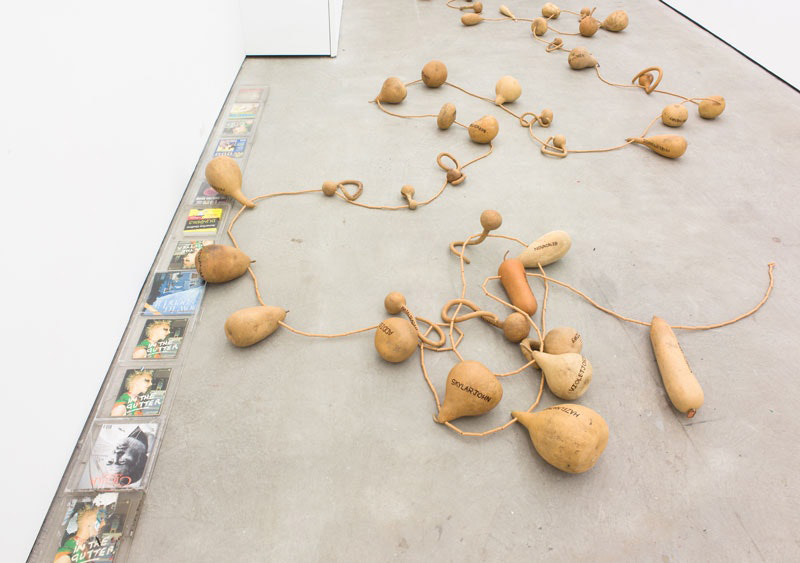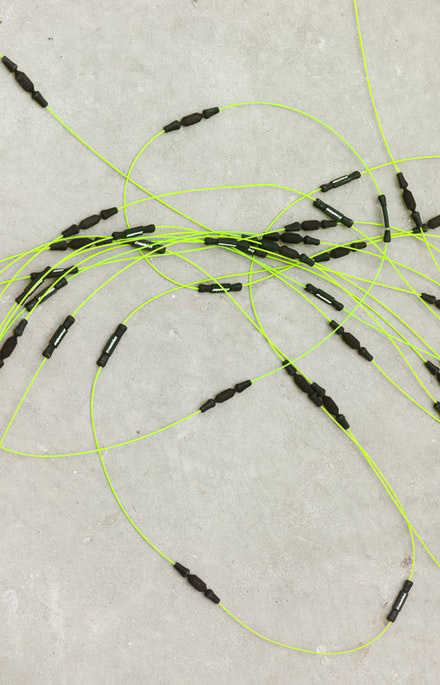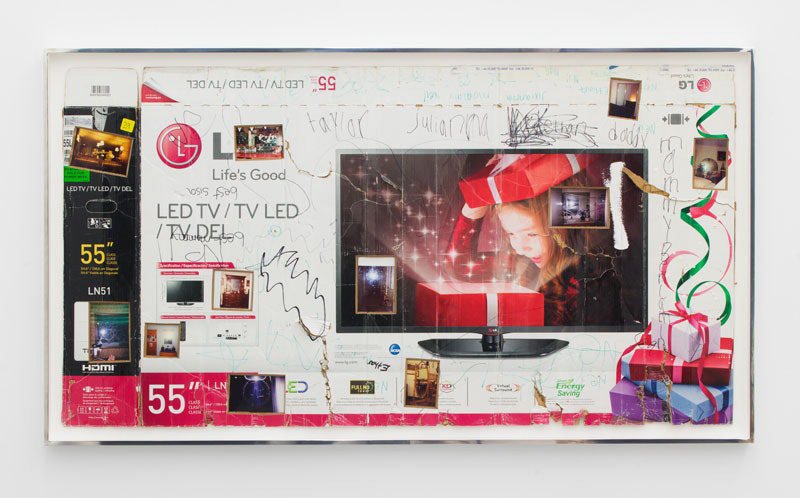
- Source: The Brooklyn Rail
- Author: Vijay Masharani
- Date: February 7, 2019
- Format: DIGITAL
Torey Thornton: Sustenance Traversing Foundational Urgencies
(STFU [some])(Re-Faux Outing)
Known primarily for his painted works on paper, in his exhibition Sustenance Traversing Foundational Urgencies (STFU [some])(Re-Faux Outing), at Essex Street, Torey Thornton presents a new body of work comprised entirely of sculptures made from found objects. With this expanded palette, Thornton is able to highlight the qualities of objects in order to plot their degrees of cultural specificity or ubiquity. The pieces consider the mechanisms by which objects can slip from the former to the latter, and the ramifications of such slippages as they lead to erasure, decay, or dilution.
Though he pays careful attention their formal qualities, sourcing objects based on their color, surface quality, or other aesthetic affinities, Thornton also chooses objects according to more specific criteria, tending to favor those that are quite cheap, and have some kind of subcultural connotation. For instance, Endangered Cabbie Named Bumble (Practitioners Raw material) (2019) is an extended coil of strung-together green Croakies ski-goggle retainers, first used by skiers in the 1970s in Jackson Hole, Wyoming. Also concerned with subculture is Legally Undone, Curbside (2018), a broken, dirty plexiglass storage bin with multiple compartments, each of which contains a used niche publication—America Online for Dummies, a few issues of WOOD Magazine, and an issue of the LA punk zine Ben is Dead. One book, presented in multiple editions with varying degrees of wear-and-tear, exudes a particular aura: Val Hennessy’s punk photobook In the Gutter. In a 2015 interview with LA-based musician and artist Brendan Fowler, Thornton describes his disaffection with the New York punk scene, lamenting how pretentious and commercial it has become—a feeling that is legitimated by objects like In the Gutter, which is now branded as a collector’s item, and sold for upwards of $300 on websites like eBay. Thornton cuts to the core of the fragility and preciousness of subculture, highlighting how it is constantly threatened by political persecution, capitalist recuperation, gentrification, and infiltration. The display of publications resembles the thumbnail view of a reselling site, like Discogs or eBay, with each item reduced from an accessible object into an inaccessible image.

Torey Thornton, Sustenance Traversing Foundational Urgencies (STFU [some])(Re-Faux Outing), installation view, ESSEX STREET, New York, 2019. Courtesy the artist and ESSEX STREET.
Thornton’s interest in how subcultural objects become commodified foreshadows a more general preoccupation with cultural or linguistic hegemony, addressed in the exhibition’s centerpiece work Untitled Political Aliens (Top Fifty US Babies 2018 Gender Mashed To Make My New) (Charming) (2018), comprised of 50 dried bottle gourds daisy-chained together using steel wire and bamboo-esque all-purpose parcel handles. Each gourd has been branded with a unique name created by combining the fifty most popular American male and female baby names in 2018: VICTORIALEO (30), SOPHIAMASON (6), LUNADANIEL (20), and so on.(Thornton has previously used this hybridized dataset in an acrylic painting on cardboard with almost the same title.)
In an era when cisnormative rituals like gender-reveal parties persist, to embrace a both-and approach towards gender seems, ostensibly, emancipatory. However, this gesture is undercut by its medium: the “a-gendered” names are inscribed with violence, burned into the flesh of the dried gourds—many overtly phallic, others more ambiguously organlike. In addition, despite the fact that bottle gourds originate in Africa and Asia, the names read overwhelmingly white, save for ones like MOHAMMED and NIAMEY (here respectively fused with AURORA and LANDON). Even as they haphazardly represent as “American names,” the small number of names with origins outside Europe and the US reifies the list’s overall whiteness, rather than significantly diminishing it.

Torey Thornton, Endangered Cabbie Named Bumble (Practitioners Raw material), 2019. Eyewear retainers and plastic hardware, 54 x 45 inches. Courtesy the artist and ESSEX STREET.
The discontinuity between the objects and the names is jarring—removed from their specific histories and multifarious uses, the gourds are unceremoniously relegated to the role of hosts and forced to bear what effectively amounts to an aggregate of hyper-present White American names. The consequences of this burden are borne out in the work’s barren quality, as the wounded fruits’ dryness—originally utilitarian insofar as gourds were used as storage containers—seems corpse-like.

Torey Thornton, How Many Ways To Understand Moving Image, How Many For Vanity, 2018. Found color photo prints, found cardboard with polished aluminum frame, 40 x 71 1/4 x 3 inches. Courtesy the artist and ESSEX STREET.
In the sole wall-mounted work, How Many Ways To Understand Moving Image, How Many For Vanity (2018), Thornton insets six photographs of camera flashes reflected in mirrors. These images are emblematic of a strategy of the show itself: the photographs both invite and evade spectatorship—the flashes overexpose parts of the image, asserting their existence but disallowing you to properly catalog or register their contents. In many ways, Sustenance Traversing Foundational Urgencies (STFU [some])(Re-Faux Outing) reads as a meditation on the overlapping and dismal fates of cultural production today, in which objects are commodified, aggregated, and relegated to the status of “content,” or gentrified by a collector class. Here, art itself can be figured as a victim, insofar as these processes flatten out racial and cultural specificity. Of course, when it comes to these pervasive forces of recuperation and cooptation, contemporary art is by no means exempt, so it’s unsurprising that the pieces justifiably read as a little cagey, protective, or encrypted in an attempt to anticipate, dodge, or postpone their own appropriation or judgement.

